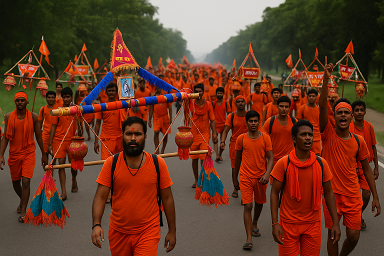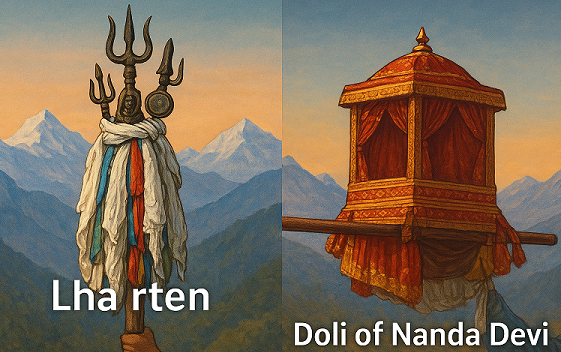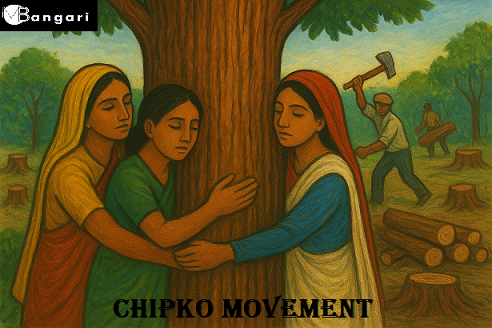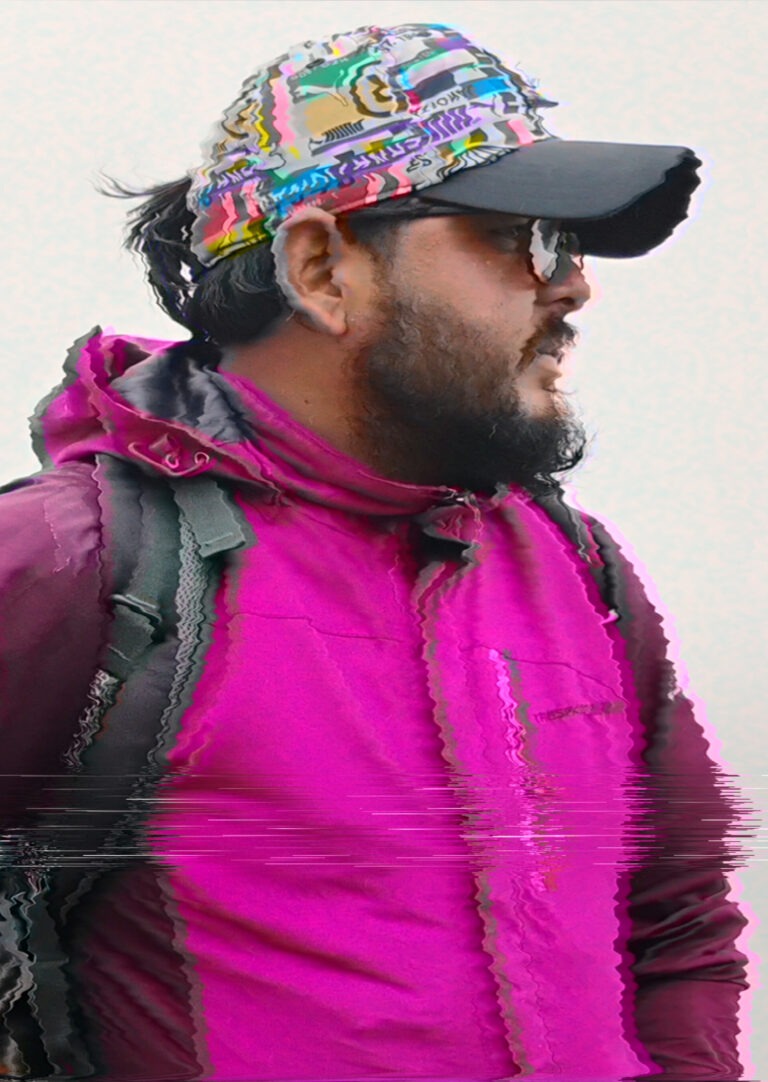By – Mohit Bangari
23 July 2025

Explore Himalaya With Me!!

Every year during the Shravan month, a special scene unfolds on North India’s highways. Thousands and thousands of saffron-clad devotees walk barefoot, chanting “Bol Bam!” and carrying sacred Ganga water in decorated Kanwars for their beloved Bhole Baba. This is the Kanwar Yatra, one of the largest religious pilgrimages in India.
Let’s understand the history, faith, and modern-day transformation of this spiritual journey.
The roots of the Kanwar Yatra are found in Hindu scriptures and ancient stories.
As per legend, when Lord Shiva drank the poison (Halahal) that emerged from the Samudra Manthan, he held it in his throat to save the world. To cool his burning throat, devotees offered water from the holy Ganga river.
Since then, during the month of Shravan (believed to be the time when Shiva drank the poison), devotees offer Gangajal to Shivlings at major temples.
Some historians say this practice started centuries ago, mostly by hermits and villagers from Uttar Pradesh and Bihar. It wasn’t a mass movement at that time — it was simple and spiritual.
In past centuries, the journey was done by foot, without any facilities. People carried Gangajal in pots hanging on bamboo sticks (Kanwars), walked for over 100–200 km, and quietly offered water at their home temples.
Kanwar Yatra is a symbol of pure devotion (Bhakti) to Lord Shiva.
Devotees believe offering Gangajal to Shivling during Shravan fulfills wishes, removes sins, and brings peace.
Many observe strict fasts, stay silent (Maun Kanwariya), and avoid worldly pleasures.
They don’t place the Kanwar on the ground during the journey — out of respect.
The final water offering is done on Shivratri, the most important day of the month.
Haridwar to Delhi/UP
– Most popular route among North Indian devotees.
Sultanganj (Bihar) to Deoghar (Jharkhand)
– Known as Shravani Mela, very sacred for people from Bihar and Jharkhand.
Gangotri or Gaumukh to Rishikesh/Haridwar
– Chosen by more spiritually intense Kanwariyas.
Other routes include Ganga ghats in Garhmukteshwar, Rishikesh, Allahabad, etc.
In the last 20–25 years, Kanwar Yatra has seen big changes, especially due to urban influence, youth involvement, and technology.
Earlier it was a quiet and spiritual walk.
Now, you see decorated trucks, bike rallies, loud DJ music, and even Kanwar tattoos.
Group travel (sanghs) has become popular — with organised food stalls, bands, and social media sharing.
Kanwariyas now track routes on GPS, and many livestream their journey.
Vlogs, reels, and photo shoots have become part of the yatra culture.
State governments make dedicated roads for Kanwar Yatra, such as the Kanwar Path in Uttar Pradesh.
Cities like Meerut, Haridwar, Muzaffarnagar, and Ghaziabad witness full road conversions.
Kanwar Yatra is a boon and a challenge for local people living on major pilgrimage routes.
Local economy boosts due to sale of food, clothes, religious items, and camping facilities.
Many locals set up free langars (community kitchens), earning spiritual merit.
Transport operators and tent providers earn well during the month.
Traffic jams and roadblocks are common, especially on highways.
Loud music and DJ processions sometimes disturb hospitals, students, and elderly.
Cleanliness becomes a major issue. Despite efforts, many areas face garbage piles and water wastage.
Shops near highways often report reduced business due to road restrictions.
Local administrations try hard with police force, barricading, and mobile toilets, but the scale of the event makes management tough.
Kanwariyas mostly come from:
Uttar Pradesh, Bihar, Jharkhand, Delhi, Haryana, Punjab, and some parts of Rajasthan and Madhya Pradesh.
Many are youngsters, but even elderly and women participate.
Some walk barefoot for 100-200 km, while others use cycles, bikes, or vehicles.
Types of Kanwariyas:
Dak Kanwariya – Run to and from Ganga quickly, like a postal service.
Maun Kanwariya – Don’t speak until water is offered.
Group Sanghs – Large groups with full facilities.
Starts: Around 10 July 2025
Peaks: Near 9 August 2025 (Shravan Shivratri)
Location Hotspots: Haridwar, Sultanganj, Rishikesh, Gaumukh, Gangotri
“Pehle to bas ek lota le ke jaate the. Ab toh DJ wale Kanwar nikalte hain,” – a shopkeeper from Haridwar
“Ek mahine ke liye toh poora highway badal jaata hai. Par Bhole Baba ke bhakton ke liye sab bardasht hai,” – a dhaba owner near Muzaffarnagar
Plastic ban near Ganga ghats during the Yatra.
Police install CCTV cameras and drone monitoring.
Volunteer groups now promote clean yatra campaigns.
Kanwariyas are being encouraged to reduce DJ noise and avoid aggressive behavior.
The Kanwar Yatra is more than a pilgrimage. It is a movement of faith, deeply rooted in India’s spiritual DNA. While the devotion and love for Lord Shiva remains unchanged, the way the Yatra is carried out is evolving.
From peaceful walks to DJ-fuelled processions, from quiet prayers to Insta reels, the Kanwar Yatra has embraced the modern world. But with great numbers comes great responsibility — for both devotees and local authorities.
In the end, the message of Kanwar Yatra is simple — walk for faith, not show-off; and remember that Shiva lives in simplicity.
You can also explore more on Himalayan treks like Darma Valley, Adi Kailash, and others on my website mohitbangari.com, where I share full guides, routes, permit tips and cultural info.
By – Mohit Bangari
23 July 2025
Do you know about Ramman festival of Salud-Dungra village? It’s one of the intangible world cultural heritage of India in UNESCO. You can read a detailed article on this topic here.



Explore Himalaya With Me!!


Explore the beauty and cultures of the Himalayas, from Jammu and Kashmir to Arunachal Pradesh, Tibet and Nepal. My blog shares stories, pictures, and fun articles about this amazing region. Come along on a journey where each mountain has a tale and every valley hides a treasure. Join me as I discover the magic of the mountains together.
Welcome to my Himalayan Adventure!